While Hollywood was still an anonymous LA suburb, one British seaside city was busy inventing the "language" of cinema, during a glorious decade from the late years of Queen Victoria's reign into the start of the 20th Century. That place was Brighton and Hove on England's south coast, and its role in helping found cinema as an art form has the colour, invention and striking characters of any big-screen tale.
More like this:
- The bold pioneers of cinema
- The daring director who broke taboos
- The women who shaped Hollywood
When, for example, George Albert Smith realised that reversing the direction of the film in the camera could create unexpected visions to dazzle new audiences, he introduced cinema to the wonder of special effects – as in his 1900 film The House That Jack Built, where a toy house destroyed by a boy magically appears to rebuild itself.
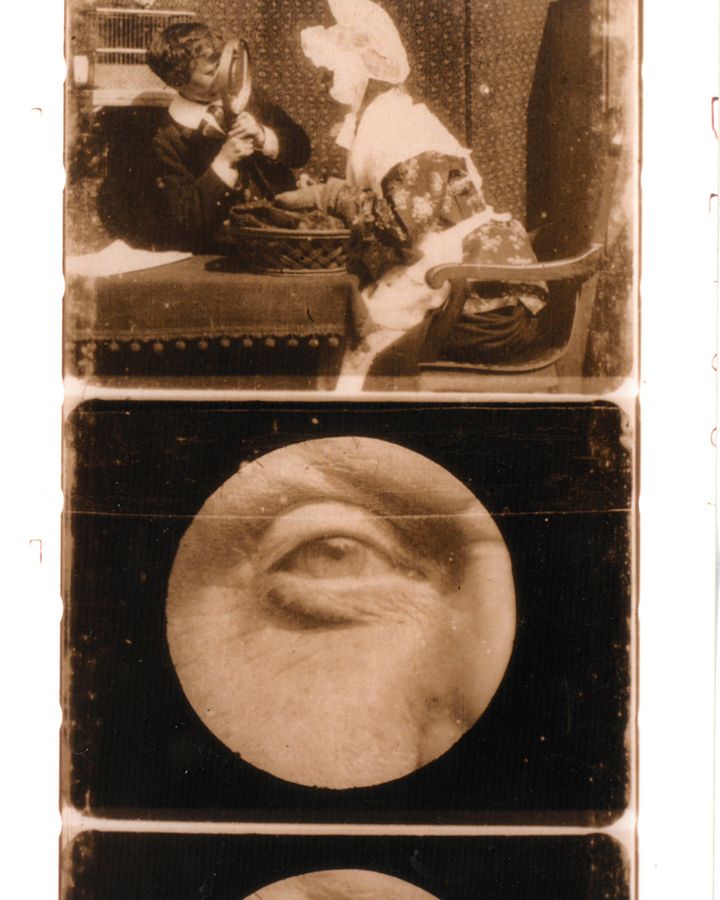
Grandma’s Reading Glass (1900) includes the first use of the close-up – this shows the actual edit between shots (Credit: Screen Archive South East, University of Brighton)
Other cinematic landmarks followed by the Victorian British seaside: the first close-up; first editing for narrative; first cutaways and dissolves; first screen kiss; first movie chase. Brighton inventors like William Friese-Greene helped develop the first commercially practical colour film and cameras between 1903 and 1908. Living up to its louche reputation, the city could even have produced the first "blue movie" – the 1897 Woman Undressing is sometimes credited to Arthur Albert "Esmé" Collings, marketed as only suitable for viewing in "gentleman's smoking rooms".
Several elements contributed to the town's starring role in early cinema, explains Suzie Plumb, who curated the exhibition Experimental Motion: The Art of Film Innovationat the Brighton Museum and Art Gallery in 2016.
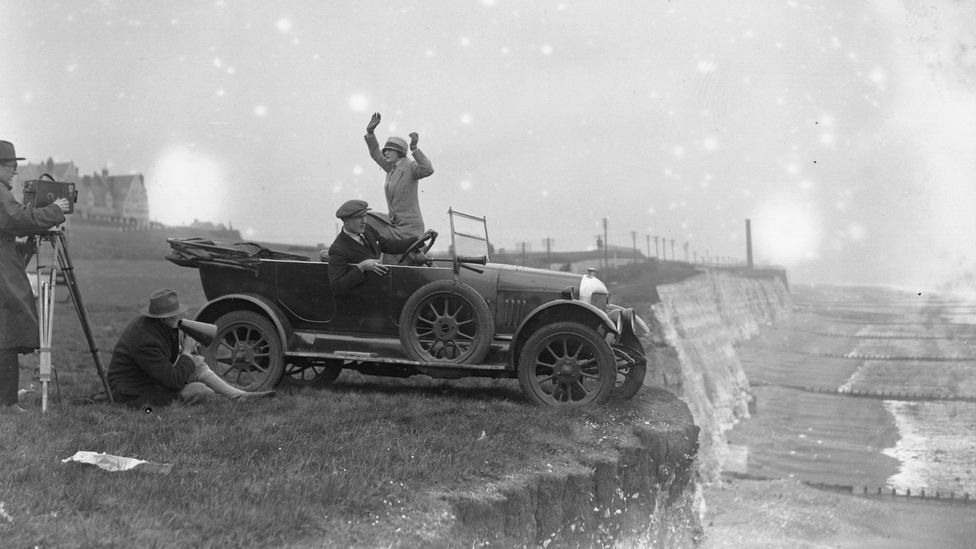
A scene from The Thrill is filmed on the cliffs at Brighton in 1926 (Credit: Fox Photos/Getty Images)
As an established seaside resort, the 19th-Century city already had a thriving photographic scene – lens and camera suppliers, processing labs – serving Victorian holidaymakers wanting holiday mementos. Add generally good weather and light (by British standards). "And you also had a fantastic natural set," says Plumb. "The sea, the Downs and the city." Just as importantly, 1890s Brighton – as now – was a place where creativity and free thinking were at the fore, making it fertile ground for a new art form to take root within a year of France's Lumière brothers (Auguste and Louis) screening the first moving images in Paris in 1895.
From early 1896 to the end of 1900, at least 176 films were made in Brighton and Hove – over a decade before Hollywood launched itself as America's filmmaking centre in the 1910s. George Albert Smith's 1903 film Mary Jane's Mishap, meanwhile, was described by cinema historian John Barnes as "the first modern film" for its bringing together of multiple techniques including long shots, close-ups, stop-motion and super-imposition.
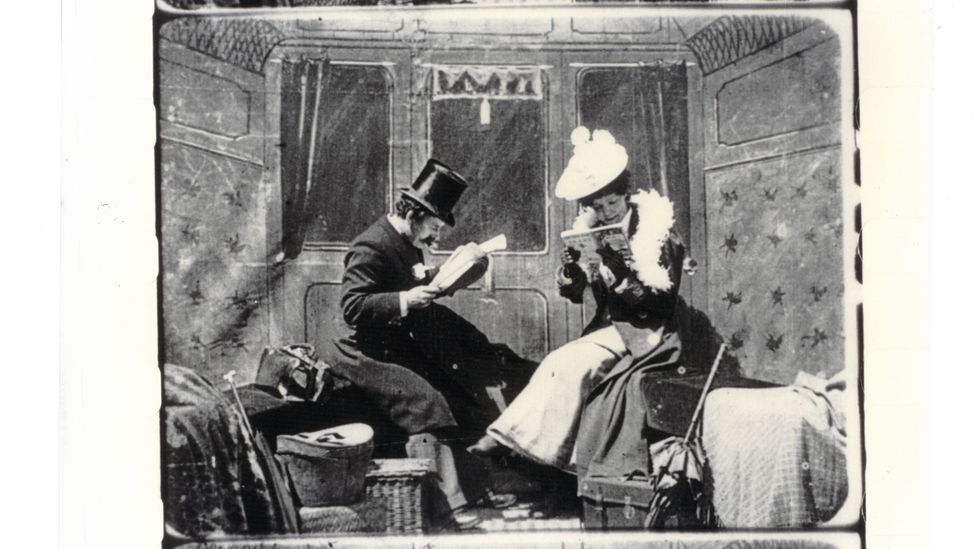
Smith's Kiss in the Tunnel (1899) featured the director and his wife Laura Bayley – the UK’s first screen actress (Credit: Screen Archive South East, University of Brighton)
Entertainment entrepreneur George Albert Smith was a key player in Brighton's pioneering film scene. "Smith brought together a combination of forces," says Frank Gray, principal lecturer at the University of Brighton's School of Media, and author of the 2019 book The Brighton School and the Birth of British Film. "There were his activities as a magic lanternist – the technology, creation of shows, understanding of 'editing' to work from slide to slide. Then there was the presence of his wife Laura Bayley with her background as a professional actor. Add interest in illusionism and spectacle."
Plumb takes up the story, from when Smith goes to London and sees the first Lumière film at a March 1896 screening in Leicester Square. "Smith races back to Brighton thinking this is the next big thing... He starts thinking about cameras, and goes to visit Alfred Darling – a local engineer who makes things from bits of buses and coffin handles! Smith says 'I want a camera' – then Darling gets excited and starts playing around..."
The magical years of invention
In 1896, Brighton leapt to the forefront of what we now know as cinema – making 2021 the 125th anniversary. A brief chronology of that year shows the pace of development. Within two weeks of Smith seeing the Lumière films in London, he was devising moving image shows at Brighton Aquarium using optical lantern illustrations to create "brilliant dissolving views and beautiful mechanical and dioramic effects". In late March, the first UK film screening outside London took place at a gallery opposite the West Pier.
In July 1896, Robert Paul shot the first movie known to have been made in the city – a boat landing on Brighton beach. Over the next six months, more than two dozen short films were shot in Brighton by new directors including Esmé Collings, whose Boys Under Pier captured boys scrambling for coins dropped by holidaymakers under the West Pier.
In November, Hove Camera Club's annual exhibition included several films made by another pioneering director, James Williamson – who went on to shoot more than 100 films in the city, featuring landmark cinematic innovations in both technique and subject.
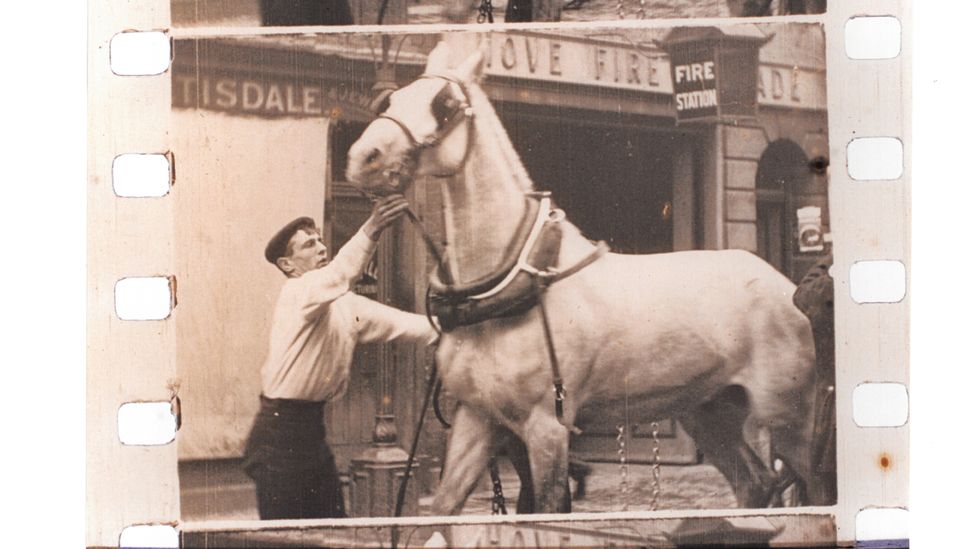
James Williamson's Fire! (1902) was an early innovative realist drama filmed on the streets of Hove and in his studio (Credit: Screen Archive South East, University of Brighton)
Williamson's 1900 film Attack on a China Mission – Blue Jackets to the Rescue (depicting a scene from the Boxer Rising in China, but actually filmed in Hove) features the first recorded use of a reverse angle shot to show action from the opposite point of view. A year later, he gave us the first recorded movie chase in Stop Thief!. In 1902, meanwhile, two films about soldiers from the Boer War – A Reservist, Before the War, and After the War and The Soldier's Return – became foundation stones for cinematic social realism.
Creating the mechanics of cinema
Brighton's filmmaking pioneers seemed to immediately grasp the potential for cinema to be more than mere moving images on a screen. "They began thinking of film as a way to tell a story rather than just showing an event," says Suzie Plumb. She contrasts their narrative invention with other early movies, such as those that mimicked theatre by filming actors entering from the wings, or using written titles to aid narrative rather than telling a story using cameras and action. Movie-making centres appeared around the city. George Albert Smith turned the Pump Room at Hove's St Ann's Well Gardens into a "film factory" including a special glass-sided studio and laboratory. Here he pioneered double-exposure for effects, including in the 1898 films The Corsican Brothers and Photographing a Ghost. On nearby Cambridge Grove, James Williamson's Kinematographic Company erected another glasshouse film studio, while prototype cinemas opened to show the dozens of films being made in Brighton. Four 'Mutoscope' parlours opened in 1897 alone, where early film fans flocked to put pennies into coin-operated viewing machines.
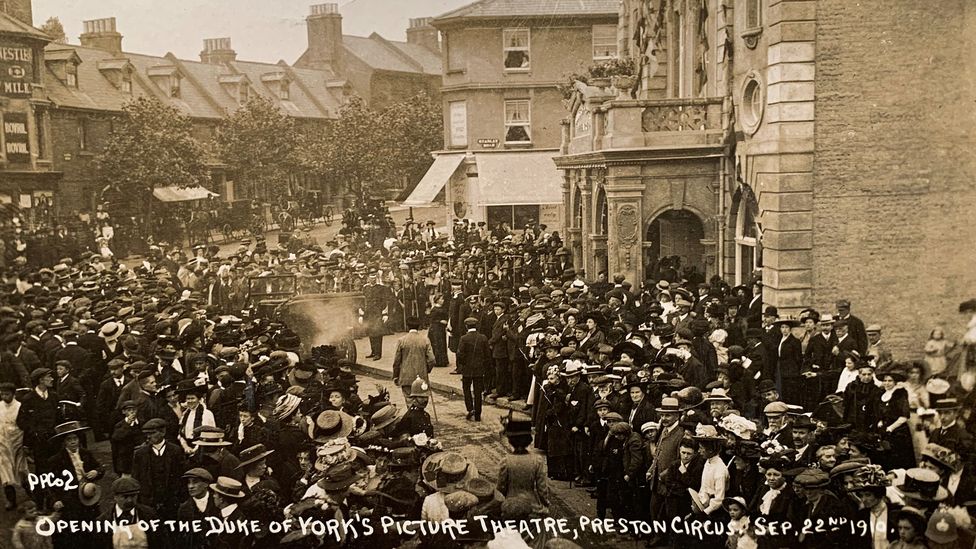
Crowds attend the opening of the Duke of York's, Britain's oldest surviving purpose-built cinema, in 1910 (Credit: Brighton and Hove Museums)
On Chester Terrace, meanwhile, Alfred Darling's workshop was turning out ground-breaking cameras as vital to the impact of the Brighton School as the filmmaking innovations of its directors. "Smith might say 'I really want to do a close-up shot' – then Darling makes a camera to achieve that," explains Plumb. Which gave audiences the first ever close-ups in Smith's 1900 short Grandma's Reading Glass. His close-up film Spiders on a Web, made the same year, was also among the first ever nature films.
Darling's iconic cameras – many now on display at Hove Museum – look much like devotional objects, their lenses like windows into another world, set in dark wood burnished by time. One 1896 camera was made to experiment with 42mm gauge film (before 35mm became standard), while the 1899 Biokam was Darling's realisation of Smith's desire for the world's first amateur film camera. There's also the world's first special-effects camera built in 1900, plus a pioneering 1910 colour film camera.
Brighton's movie-maker women
The key role of women like Laura Bayley is also increasingly acknowledged. "Given her understanding of acting and the professional stage, I just can’t see how Smith [her husband] could have conceived his scenarios and executed them without her active involvement," argues Gray. "We should now refer to them as co-directors." Another female Brighton film pioneer was Elizabeth Alice Frances Hawkins-Whitshed. Sometimes known by her married name, Mrs Aubrey Le Blond, this intrepid mountaineer shot at least 10 films of winter sports in Switzerland around 1900, her depictions of events like the Cresta Run bob-sleighing helping create the genre of sports coverage.
The Brighton School reached out to the US, too. Gray highlights a 1900 catalogue of films available to that market, in which 56 offerings were Brighton-made. "In terms of film form, Smith and Williamson also influenced their American contemporaries, especially Edwin Porter – a key figure in early American film," says Gray.
The 2016 Brighton Museum exhibition also drew an intriguing parallel with the city's most famous contemporary film director, Ben Wheatley, maker of boldly acclaimed features including A Field in England (2013) and High-Rise (2015). Wheatley turns out to be something of a spiritual successor of the Brighton School in his willingness to invent hardware for a specific effect. Among gizmos created in the past decade with cinematographer Laurie Rose is "The Mesmeriser" – fashioned using a lens from a cheap plastic toy telescope to create unique depth-of-field effects for innovative modern feature films. Brighton's early cinema pioneers would have approved.
If you would like to comment on this story or anything else you have seen on BBC Culture, head over to our Facebook page or message us on Twitter.
And if you liked this story, sign up for the weekly bbc.com features newsletter, called The Essential List. A handpicked selection of stories from BBC Future, Culture, Worklife and Travel, delivered to your inbox every Friday.
https://ift.tt/3uTnpqd
Film
Bagikan Berita Ini














0 Response to "Brighton: The birthplace of the first modern film - BBC News"
Post a Comment